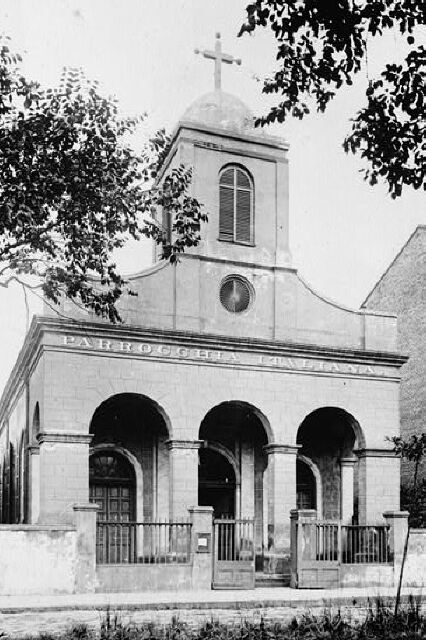| The Old Mortuary Chapel: New Orleans' Oldest Surviving Church |
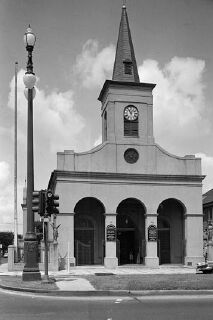
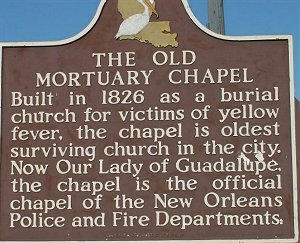
| The Old Mortuary Chapel as it looked in 1880 |
| 1964 |
| The church's historical marker. |
| 2006 |
| The link to this page is: http://old-new-orleans.com/NO_Mortuary_Chapel.html View of French Quarter showing locations of Mortuary Chapel & St. Louis No. 1 Back to Old New Orlenas Whispers |
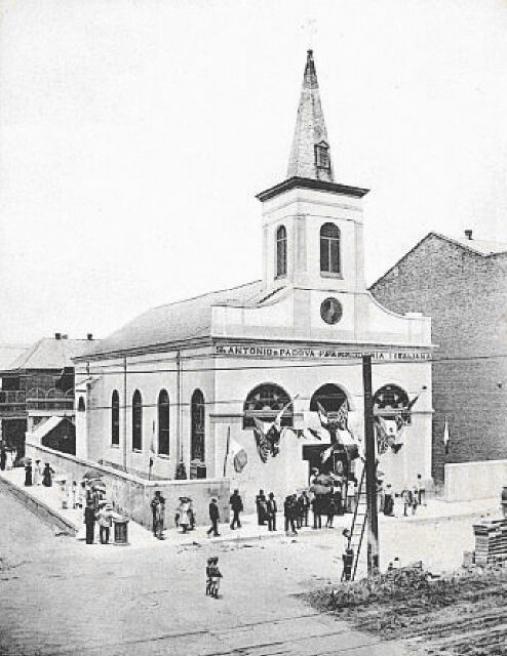
The first church built in New Orleans was St. Louis Church, now St. Louis Cathedral. The
original St. Louis Church was constructed 100 years earlier than the Mortuary Chapel, however,
it burned and was rebuilt twice, so the Mortuary Chapel is the oldest original church still
standing.
In the 1820's, the New Orleans City Council declared it illegal to bury victims of the city's annual
Yellow Fever epidemics from St. Louis Cathedral (then St. Louis Church, the only Catholic Parish
in the city, which was majority Catholic). At that time, the source of the disease was still
unknown and there was a concern that the church might somehow become contaminated with
the constant funeral services performed throughout the Yellow Fever season; there was, also, a
fear that contamination might occur as the dead were transported through the streets to the
church and on to the cemetery. Their fears were understandable, between 1817-1860, Yellow
Fever epidemics struck the city 23 times, and the cause had yet to be identified.
Land for a mortuary chapel was chosen at the corner of North Rampart and Conti Streets, within
walking distance of St. Louis (No. 1) Cemetery and construction began on the church, whose sole
function would be to bury those who died during Yellow Fever season, from July to December.
The building was completed in 1827 and it was dedicated as The Chapel of St. Anthony of Padua.
Services began immediately. In the beginning, no one was allowed in the chapel except the
priests and altar boys who performed the mass for the dead, and the pall bearers who carried
their burden into and out of the building. The victim's family, in black, with the women heavily
veiled, observed the scene through the open doors of the church. Later on, the mourners were
allowed to enter the sanctuary but, for many years, no pews or seats of any kind were installed.
In the 1840's, records show that the chapel began to take the overflow baptisms and wedding
services from St. Louis Cathedral and there are records of some masses being offered, as well.
By the 1870's, with an influx of Italian immigrants in the neighborhood and no longer a need for
a chapel devoted to Yellow Fever services, St. Anthony became the parish church for a
congregation made up almost entirely of Sicilian immigrants, and remained so for many years.
By 1918, the Dominican order took over the duties of the church and it was renamed Our Lady of
Guadalupe. For a long time, it's served as the official chapel of the New Orleans Police and Fire
Departments.
The old Mortuary Chapel has had an extraordinary history. Below is an excerpt from a haunting
description of the yellow fever epidemic of 1853, when almost 6,000 people perished in one
month alone, taken from "The Diary of A Samaritan" by William L. Robinson:
"[As part of the experiments to control the disease] tar was set on fire around and in the
cemeteries...in the yards of private houses...and in the middle of Canal, Rampart and Esplanade
streets. At sunset, when all were simultaneously fired, a pandemonium glare lighted up the
city. Not a breath of air disturbed the dense smoke, which slowly ascended in curling
columns...here it seemed equipoised, festooning over our doomed city like a funeral pall and
there remaining until the shades of night disputed with it the reign of darkness.
"The [chapel] contiguous to the graveyard on Rampart Street was a thronged receptacle of the
dead and their mourners during the day until after dark. Hence arose the mournful Miserere,
filling the air with its melancholy influence and heightening still more the universal
despondency and sadness."
-- Nancy
original St. Louis Church was constructed 100 years earlier than the Mortuary Chapel, however,
it burned and was rebuilt twice, so the Mortuary Chapel is the oldest original church still
standing.
In the 1820's, the New Orleans City Council declared it illegal to bury victims of the city's annual
Yellow Fever epidemics from St. Louis Cathedral (then St. Louis Church, the only Catholic Parish
in the city, which was majority Catholic). At that time, the source of the disease was still
unknown and there was a concern that the church might somehow become contaminated with
the constant funeral services performed throughout the Yellow Fever season; there was, also, a
fear that contamination might occur as the dead were transported through the streets to the
church and on to the cemetery. Their fears were understandable, between 1817-1860, Yellow
Fever epidemics struck the city 23 times, and the cause had yet to be identified.
Land for a mortuary chapel was chosen at the corner of North Rampart and Conti Streets, within
walking distance of St. Louis (No. 1) Cemetery and construction began on the church, whose sole
function would be to bury those who died during Yellow Fever season, from July to December.
The building was completed in 1827 and it was dedicated as The Chapel of St. Anthony of Padua.
Services began immediately. In the beginning, no one was allowed in the chapel except the
priests and altar boys who performed the mass for the dead, and the pall bearers who carried
their burden into and out of the building. The victim's family, in black, with the women heavily
veiled, observed the scene through the open doors of the church. Later on, the mourners were
allowed to enter the sanctuary but, for many years, no pews or seats of any kind were installed.
In the 1840's, records show that the chapel began to take the overflow baptisms and wedding
services from St. Louis Cathedral and there are records of some masses being offered, as well.
By the 1870's, with an influx of Italian immigrants in the neighborhood and no longer a need for
a chapel devoted to Yellow Fever services, St. Anthony became the parish church for a
congregation made up almost entirely of Sicilian immigrants, and remained so for many years.
By 1918, the Dominican order took over the duties of the church and it was renamed Our Lady of
Guadalupe. For a long time, it's served as the official chapel of the New Orleans Police and Fire
Departments.
The old Mortuary Chapel has had an extraordinary history. Below is an excerpt from a haunting
description of the yellow fever epidemic of 1853, when almost 6,000 people perished in one
month alone, taken from "The Diary of A Samaritan" by William L. Robinson:
"[As part of the experiments to control the disease] tar was set on fire around and in the
cemeteries...in the yards of private houses...and in the middle of Canal, Rampart and Esplanade
streets. At sunset, when all were simultaneously fired, a pandemonium glare lighted up the
city. Not a breath of air disturbed the dense smoke, which slowly ascended in curling
columns...here it seemed equipoised, festooning over our doomed city like a funeral pall and
there remaining until the shades of night disputed with it the reign of darkness.
"The [chapel] contiguous to the graveyard on Rampart Street was a thronged receptacle of the
dead and their mourners during the day until after dark. Hence arose the mournful Miserere,
filling the air with its melancholy influence and heightening still more the universal
despondency and sadness."
-- Nancy
| 1905 |
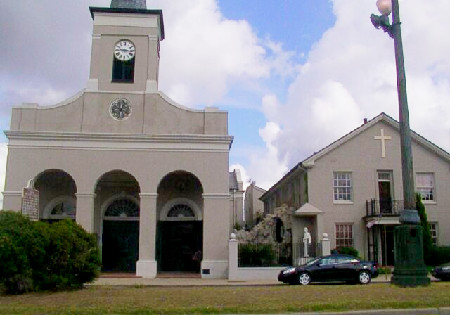
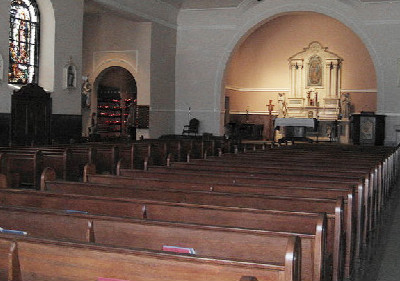
| 2008 |
